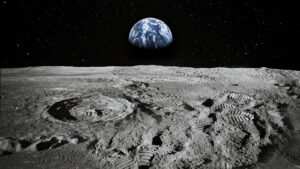NASA’s lunar ambitions are branching out beyond leaving footprints on the moon; they’re funding research for what you could call ‘lunar gardening.’ More specifically, NASA is interested in how moon soil, called lunar regolith, impacts plant and animal systems, a first step in exploring lunar agriculture.
NASA recently allocated funding for space biology research, with a portion designated for Professor Graham Peers in the Colorado State University Department of Biology. Peers specializes in studying photosynthetic efficiency and algal ecophysiology. In a recent interview, we discussed the implications of the new funding, NASA’s interest in cultivating plants in space and the future direction of the research.
Question: What is regolith and why is NASA interested in studying this?

Answer: NASA is prioritizing work around sustainable human communities on the moon. One active area of exploratory research to that end is lunar agriculture. The surface of the moon is covered in something that looks like dirt called regolith, but the moon has no atmosphere and no life – so it’s very different from the soil you see on Earth. This lunar regolith – which means “blanket” and “rock” in Greek– also has a very different elemental composition and chemistry than what plants normally thrive on.
Last year, scientists in Florida found that when you try to grow plants on genuine lunar regolith, they become stunted and physiologically stressed. The question now is why and how do we improve lunar regolith for the growth of plants? We hypothesized that the poor plant health was due to high amounts of the toxic element chromium. For this project with NASA, we proposed to use an algae species known to rehabilitate chromium-poisoned earth soils to see if it could grow and detoxify the regolith. Our hope is that the algae will sequester the chromium and therefore release the plants from stress.
Q: What are the applications for deep space exploration of this work?
A: Sustainable life off planet will involve recycling of gases like the production of oxygen to breathe and the consumption of carbon dioxide. Plants do a great job of both those things. Additionally, plants could provide a source of nutrition to astronauts on long space missions. They have already grown, harvested and eaten salads on the International Space Station! But you need to be able to grow a lot of plants to make a dent in human needs, so large scale plant farming will probably need to happen in regolith at some point.
Q: What specifically is your lab working on for this NASA project?
A: We are going to be responsible for growing plants on regolith simulant because you must pretty travel far to get the real stuff! Once the plants are grown, we will assess their physiology and heavy metal content. We are also going to use a strain of algae to try and detoxify metals in the regolith and see if that improves plant health.
Q: Is this a subject your lab has been looking at already? How does it relate to your ongoing research portfolio?
A: Our lab group is interested in the applied aspects of algal biology, although this project is certainly more forward thinking than most of the work we do. Currently, we are also funded by NASA to develop and test instruments that can measure plant health in space. This is a collaboration with Joe Von Fischer in the Department of Biology at CSU and Nikira Labs, Inc. of California.
Q: What are some challenges you expect to see when conducting this work?
A: Coordination! It’s always a challenge when working with folks at other institutions. There is going to be a lot of exchange of live materials, people and data to make these experiments happen in a timely fashion. Luckily, we’ve got a great working relationship with our partner scientists at NASA-AMES.